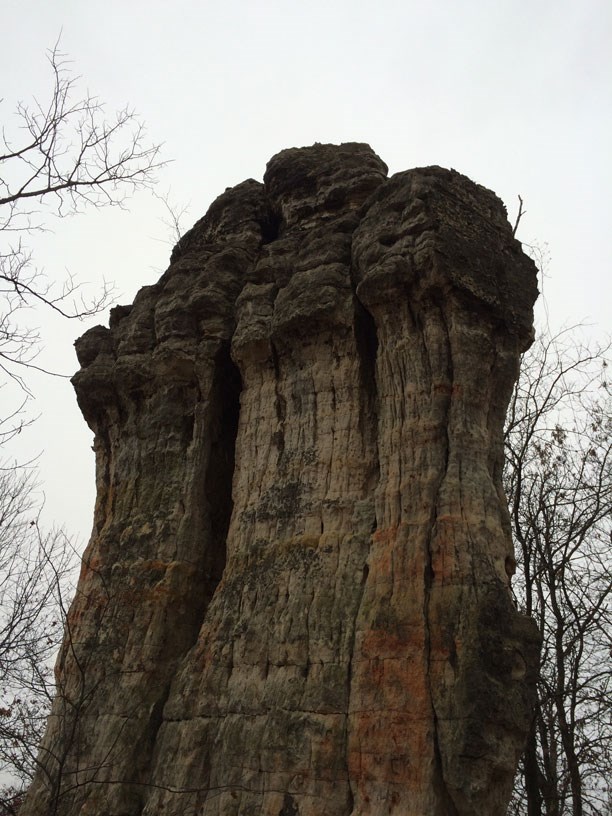Please follow the SNA guidelines at http://www.dnr.state.mn.us/snas/rules.html while visiting this earthcache.
Note: This cache is located in a Minnesota Scientific and Natural Area (SNA). These areas are set aside for nature observation and education, but are not meant for intensive recreational activities. As such, please recognize the following rules:
1. Please do NOT disturb any of the rock formations or wildlife in this area. Leave plants, animals, rocks, and other natural elements in place to fulfill their life cycle and role in the environment.
2. There is no camping or picnicking at this location.
3. Please do not use any type of off-road vehicle (bicycle, snowmobile, quads) on the SNA site.
4. Pets, to include dogs and horses, are not allowed in the SNA.
Special thanks is given to the Minnesota Department of Natural Resources for allowing us to share the beauty and history of this landmark with the caching community.
Chimney Rock

Chimney Rock is a sandstone column formation. It consists of deposits of wind-blown loess (silt) over bedrock. There are actually three formations here that consist of St. Peter Sandstone capped by Platteville limestone. The harder Platteville limestone has protected the soft sandstone from eroding, preserving the unusual and attractive chimney formations. The St. Peter Sandstone, also known as "Ottawa Sand," is generally poorly cemented, so it erodes very easily. Because of its uniform shape, it is often mined for a variety of uses, including glass, filtering, and abrasives. In this part of the state, the St. Peter Sandstone can be nearly 500 feet thick. You will find Platteville limestone and St. Peter sandstone exposed along the Mississippi River Gorge and tributary valleys through the Twin Cities.
The fact that this delicate structure has remained standing for 14,000 years is evidence that this particular location was not affected by the last glacier to cover the area. When the glacier melted, however, the melting water rushed past the sandstone, which eroded it into the column that exists today. You can see that the continued presence of wind, rain, and visitors continues to erode away at the formation.
In 1888, several of these formations in the Dakota County area were described, but today, only Chimney Rock remains in relatively good condition. Castle Rock, just south of Farmington, has collapsed, and Lone Rock, which was noted by explorer Zebulon Pike, has had much of its height worn down by erosion and visitors.
Castle Rock used to be a similar 45 foot tall pillar of sandstone located just south of Farmington, Minnesota. Early settlers thought its appearance looked like a medieval ruin, and named a nearby township after in. In 1900, a violent storm blew the top off of it, leaving it much smaller than it was, and leaving Chimney Rock the only landmark of its kind in the area.
In 1905 Chimney Rock was described by the Minnesota Academy of Natural Sciences as "the most picturesque and perfect example of columnar rock weathering in Minnesota.”
This SNA also has several scarce habitats, such as oak savannah. It also contains four rare native plant communities characteristic of the dry sandy soils at this location: kittentails, beach heather, Canada frostweed and narrow-leaved pinweed. This is also a good location for bird-watching, as it is a good place to observe red-tailed hawks, nuthatches, and juncos.
Visitors to this site may see signs of management activities such as brush cutting and removal and prescribed fire. The goal of these activities is to restore native plant communities found at Chimney Rock SNA.
For more information about Chimney Rock and the SNA, be sure to check out the DNR's page at http://www.dnr.state.mn.us/snas/detail.html?id=sna02040. They also encourage you to check out their Facebook page to see how you can get involved with their conservation efforts.
To get credit for this cache:
E-mail me with the answers to these questions using the CO link above and selecting the "Send Message" link.
1. At the main location, estimate the height and width of the Chimney Rock formation. What is the height and width of this magnificent formation?
2. Proceed to the back of the second structure listed as the “Back” waypoint. At this location, observe the color of the sand. What is the dominant color of sand at this location?
3. What reasons can you think for why the sand might be this particular color?
4. Proceed up the road to the location listed as the “Sign” waypoint. At this location, read the sign. What are the two groups that helped provide funding for this Scientific and Natural Area?
5. (Optional) This area often has beer cans and other trash accumulating at it. If you see some trash, please pick it up and carry it out with you.
Any posts with spoiler information will be removed!
Any posts without the required information submitted will be removed after seven (7) days!
This earthcache was placed with the permission of the Minnesota Department of Natural Resources. They encourage you to visit and enjoy their parks and SNAs and to please leave them in a better condition than when you found them. I am very thankful for their cooperation on this earthcache.
References:
1. Minnesota Department of Natural Resources. "Chimney Rock Scientific and Natural Area Bird Checklist." 2013.
2. Ojakangas, Richard W. and Charles L. Matsch. "Minnesota’s Geology." University of Minnesota Press, 1982.
3. Sansome, Constance Jefferson. "Minnesota Underfoot." Voyageur Press, Minneapolis, 1983.
4. Adams, Jim. “Chimney Rock is a rare sight.” Minneapolis Star Tribune, February 5, 2012.
5. Minnesota Academy of Natural Sciences. “Bulletin of the Minnesota Academy of Natural Sciences, Volumes 4-5.” 1892-1910.
6. Dakota County Historical Society. “Castle Rock.” October 2004.
7. US Department of Interior. "Geology of Parts of the Upper Mississippi Valley Zinc-Lead District." Geological Survey Bulletin 1123. US Government Printing Office, 1960.